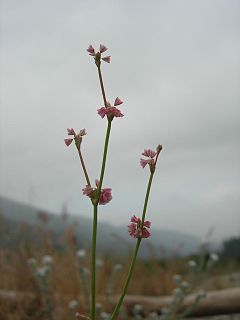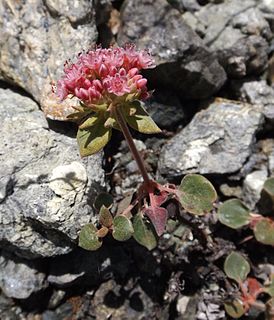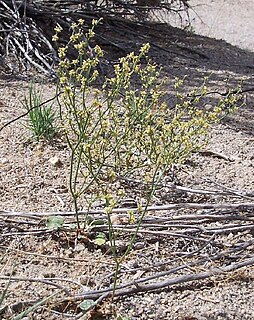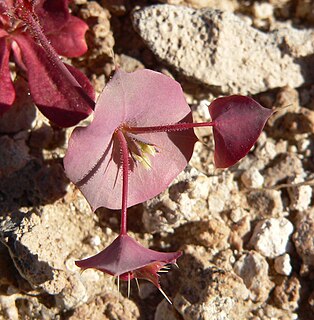Eriogonum dasyanthemum is a species of wild buckwheat known by the common name chaparral buckwheat. This plant is endemic to California where it is limited to the Northern Coast Ranges, but it is quite common in its native range.

Eriogonum davidsonii is a species of wild buckwheat known by the common name Davidson's buckwheat. This plant is native to the southwestern United States and northern Baja California. It grows in sandy or gravelly soils, mixed grassland, saltbush, chaparral, sagebrush communities as well as oak and montane conifer woodland. It is a spindly annual herb growing up to 40 centimeters in height. Leaves are fuzzy, basal, and round with wavy or wrinkly margins fuzzy. They are two centimeters wide. The plant is variable in appearance, but is usually erect with thin, naked, neatly branching stems bearing clusters of tiny flowers at widely spaced nodes. Each flower is about 2 millimeters wide, bell-shaped, and can be white, pink or red. Flowering occurs May to September.

Eriogonum deflexum is a species of wild buckwheat known by the common names flatcrown buckwheat, flat-top buckwheat, and skeletonweed. This plant is native to the southwestern United States and northwestern Mexico, where it is common and grows in a variety of habitats, especially desert scrub. It is somewhat weedy where it is most abundant. This is an annual which varies in size from small patches on the ground to tangled bushes approaching two meters in height; it may be dense or thin and spindly. This is a brown or greenish weedy-looking herb with a many-branched stem. The leaves are located at the base of the plant and are rounded and woolly and one to four centimeters long. Small clusters of flowers appear at intervals along the branches with each flower only one to three millimeters wide and white or pinkish in color.

Eriogonum elatum is a species of wild buckwheat known by the common name tall woolly buckwheat. It is native to the western United States from California to Idaho. It is a perennial herb varying in size from one half to 1.5 meters in height. Its long leaves are located at the base of the plant and can be quite long for a buckwheat, over 20 centimeters in maximum length. The erect, branching stems are thin and naked and occasionally hollow. The plant produces small to large inflorescences with clusters of tiny flowers in shades of white to dark pink.

Eriogonum incanum is a species of wild buckwheat known by the common name frosted buckwheat. It is native to the Sierra Nevada of California and extreme western Nevada. It is also known from Oregon.

Eriogonum lobbii is a species of wild buckwheat known by the common name Lobb's buckwheat or prostrate buckwheat. It is native to most of the mountain ranges of northern California and their extensions into Oregon and Nevada. It is found in a number of mountain plant communities.

Eriogonum marifolium is a species of wild buckwheat known by the common name marumleaf buckwheat. It is native to the Sierra Nevada and Klamath Mountains of California and the ranges' extensions into Oregon and Nevada.

Eriogonum nervulosum is a species of wild buckwheat known by the common name Snow Mountain buckwheat. This uncommon plant is endemic to the inland North Coast Ranges of California, where it is known from only a handful of occurrences, most of which are in Lake County. It is named for Snow Mountain, a local peak.

Eriogonum nidularium is a species of wild buckwheat known by the common name birdnest buckwheat. It is native to the sandy flats and desert dry washes of the Mojave Desert and Great Basin in the western United States, where it is common and abundant. This is a distinctive annual herb producing a thin, multibranched stem which curves in on itself to form a rounded, tangled mass.

Eriogonum plumatella is a species of wild buckwheat known by the common name yucca buckwheat. It is native to the desert southwest of the United States.

Eriogonum pusillum is a species of wild buckwheat known by the common name yellowturbans. It is native to the western United States where it grows in sandy soils in a number of habitats, especially in the Mojave Desert and Great Basin.

Eriogonum saxatile is a species of wild buckwheat known by the common name hoary buckwheat. It is native to the dry, rocky mountain slopes of California and Nevada, where it is a common plant.

Eriogonum strictum is a species of wild buckwheat known by the common name Blue Mountain buckwheat. It is a common plant of western North America from northern California to British Columbia where it is found along rocky slopes and scrubland. It flowers early in the summer.

Eriogonum ampullaceum is a species of wild buckwheat known by the common name Mono buckwheat.
Eriogonum apiculatum is a species of wild buckwheat known by the common name San Jacinto buckwheat. It is endemic to California, where it is known from the San Jacinto, Santa Rosa, Palomar, and Cuyamaca Mountains of San Diego and western Riverside Counties. Its habitat includes chaparral and wooded slopes on granite sands. This is an annual herb producing a spreading to erect, glandular stem up to 90 centimeters tall. The oblong leaves appear at the base of the plant. They are hairy and glandular in texture. Most of the stem is made up of the inflorescence, branching, spindly cyme with clusters of flowers at the tips of the branches. The individual flowers are under 3 millimeters wide and are white in color with reddish stripes.

Eriogonum butterworthianum is a rare species of wild buckwheat known by the common name Butterworth's buckwheat. It is endemic to the Santa Lucia Mountains of central Monterey County, California, where it is known from a few occurrences in the wilderness southeast of Big Sur in the vicinity of Junipero Serra Peak. Its native habitats include oak and conifer woodlands, chaparral communities, and sandstone outcrops. Eriogonum butterworthianum is a small clumpy shrub or subshrub that grows up to about 30 centimeters tall and wide. Leaves are 2 centimeters long and reddish-green in color. They are woolly, oval in shape, and curled under at the edges. The inflorescence is a cluster of flowers up to 2 or 3 centimeters wide. Each individual flower is a few millimeters wide and dull yellowish to pinkish in color. Flowers bloom June to September.

Eriogonum contiguum is an uncommon species of wild buckwheat. It is commonly known as Reveal's buckwheat and annual desert trumpet. It is native to Death Valley in California and adjacent sections of Nevada. It is commonly found in Death Valley National Park and Mojave National Preserve. Eriogonum contiguum grows in sandy to gravelly flats and slopes, or rocky hills, and lower bajadas with Atriplex species. It is an annual herb which produces an erect, spreading stem up to about 30 centimeters high. Leaves are basal, small rounded, and woolly. The many scattered inflorescences are small, compact clusters of tiny hairy yellow flowers. Flowers bloom April to June. It is threatened due to habitat degradation by off road vehicles, competition with exotic plant species, trampling, grazing, and erosion.

Eriogonum eremicola is a rare species of wild buckwheat known by the common names Telescope Peak buckwheat and Wild Rose Canyon buckwheat. It is endemic to Inyo County, California, where it is known from only a few occurrences in the Inyo Mountains and Telescope Peak in Death Valley. It grows in sandy to rocky habitat in the forests and woodlands of these desert mountains. It is an annual herb producing a spreading, glandular, reddish green stem up to about 25 centimeters tall. The rounded, woolly leaves are up to about 2.5 centimeters long and are located at the base of the stem. The scattered inflorescences are small clusters of tiny flowers which are white with reddish stripes, aging to solid red, or sometimes yellow. The plant is under protection in Death Valley National Park.

Oxytheca perfoliata is a species of flowering plant in the buckwheat family known by the common names round-leaf puncturebract and roundleaf oxytheca. It is native to the southwestern United States, where it is a common plant of the deserts and some woodland and valley areas. It is an annual herb producing a leafless stem up to about 20 centimeters in maximum height in the spring; during the winter the plant is a small rosette of oblong or spoon-shaped leaves a few centimeters wide. The plant is red-veined green, or often brown to maroon or magenta in color. The inflorescence atop the stem is punctuated by nodes at which the bracts are fused to form a cup or band up to about 2.5 centimeters wide. At the end of each branching of the stem is a similar cup of bracts partially fused around a cluster of flowers. The bracts are tipped in spinelike awns. The flowers are white to yellow-green and hairy in texture.

Eriogonum callistum is a rare species of wild buckwheat, known by the common name Tehachapi buckwheat.


















